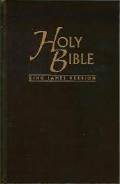
A while back, I was reading Anne of Green Gables with my children, and I was struck by the number of Biblical allusions the novel contained. Biblical language was everywhere, sprinkled throughout the characters’ dialogue and informing their choices and actions. Naturally, when I speak of the presence of “Biblical language,” I mean the language of the King James Bible.
When Anne of Green Gables was written in 1908, the King James Bible was almost 300 years old. The English language had changed considerably in that time, yet more up-to-date translations had never really managed to gain wide acceptance. The King James remained largely unchallenged as the only Bible familiar to most English-speakers throughout the world. Its magisterial phrases and memorable cadences had worked their way into common parlance, into songs and hymns, into literature, into political discourse, and into nearly every other mode of expression. The King James Bible remained the one constant in a language which was rapidly changing and fragmenting into countless regional dialects. England and America (not to mention Canada, Australia, South Africa, etc.) may have been nations “divided by a common language,” yet they long remained united by a single Bible.
May 2 of this year marked the 400th anniversary of the King James Bible, and while the King James no longer enjoys the dominance it once had, it still remains one of the top-selling English Bibles. People still quote the King James in countless common idioms and clichés, but they may no longer realize the biblical origin of those expressions. Though it is now one set of initials in an ever-expanding alphabet soup of English translations, the KJV will likely continue to exert a significant influence for years to come.
As I was noticing the allusions to the King James Bible in Anne of Green Gables, I got a little nostalgic for the days when nearly everyone read, recited, memorized, and alluded to a single translation. Ironically, the situation today—with various translations competing to become the new standard—is similar to that in which the King James was originally published. Aside from the Elisabethan English, the KJV Translators’ Preface reads like something that could have been written by any of today’s Bible translation committees. In it, the translators took pains to explain why a new translation was needed, why the new translation should not be seen as a repudiation of the work of previous English translators, how their goal was to satisfy the needs of all factions within the Church of England, and various other aspects of their translation philosophy. As is the case today, there were those who were suspicious of this new translation and any hidden agendas which might lie behind it. Those translators who took such pains to defend their work could never have imagined the enduring and unifying impact it would have.
Article Author: David Lang

